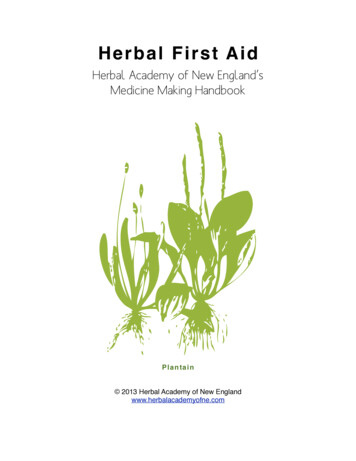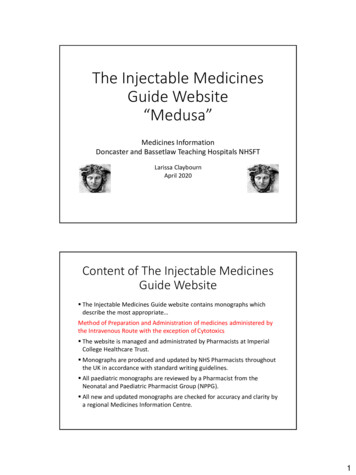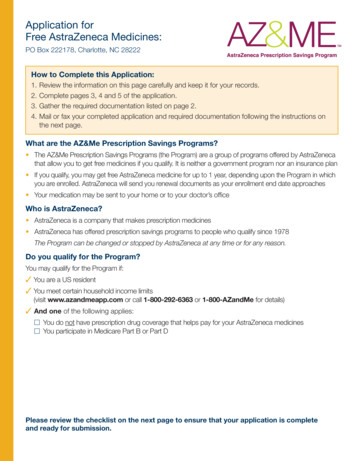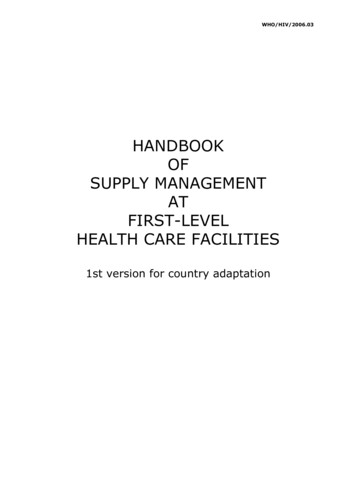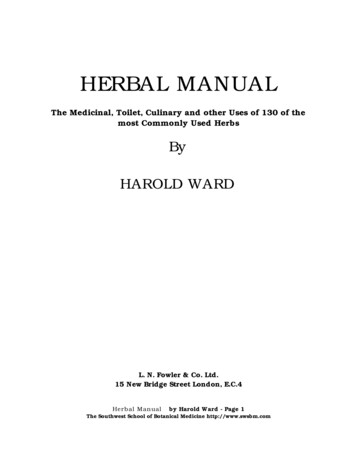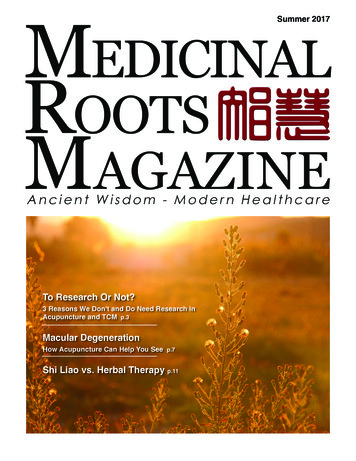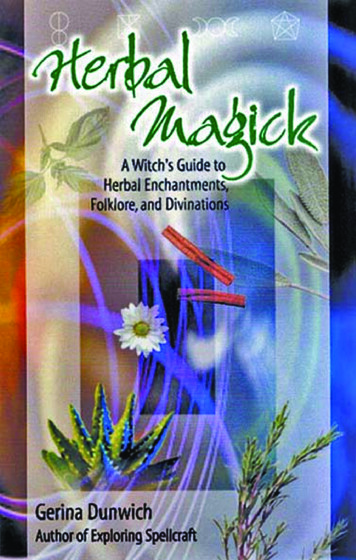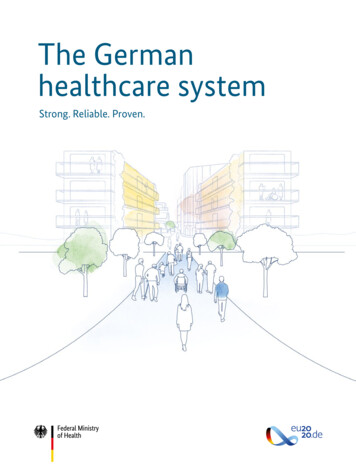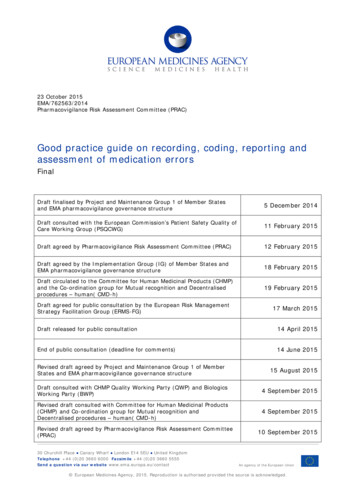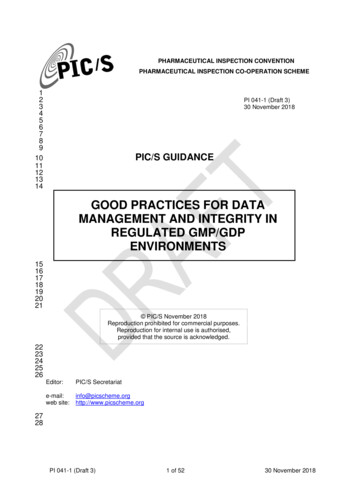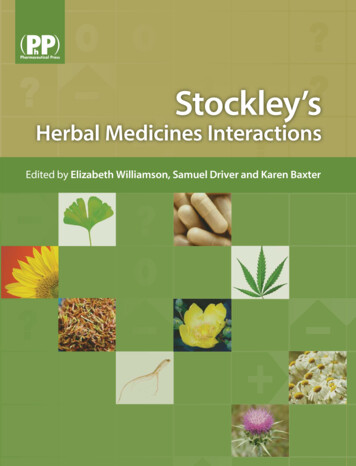
Transcription
HidX aZn¼h ZgWVa BZY X cZh ciZgVXi dch:Y iZY Wn :a oVWZi] L aa Vbhdc! HVbjZa 9g kZg VcY @VgZc 7VmiZg
Stockley’s HerbalMedicines Interactions
Stockley’s HerbalMedicines InteractionsA guide to the interactions of herbal medicines,dietary supplements and nutraceuticals withconventional medicinesEditorsElizabeth Williamson, BSc, PhD, MRPharmS, FLSSamuel Driver, BScKaren Baxter, BSc, MSc, MRPharmSEditorial StaffMildred Davis, BA, BSc, PhD, MRPharmSRebecca E Garner, BScC Rhoda Lee, BPharm, PhD, MRPharmSAlison Marshall, BPharm, DipClinPharm, PGCertClinEd, MRPharmSRosalind McLarney, BPharm, MSc, MRPharmSJennifer M Sharp, BPharm, DipClinPharm, MRPharmSDigital Products TeamJulie McGlashan, BPharm, DipInf Sc, MRPharmSElizabeth King, Dip BTEC PharmSciLondon . Chicago
Published by the Pharmaceutical PressAn imprint of RPS Publishing1 Lambeth High Street, London SE1 7JN, UK100 South Atkinson Road, Suite 200, Grayslake, IL 60030-7820, USA# Pharmaceutical Press 2009is a trade mark of RPS PublishingRPS Publishing is the publishing organisation of the Royal Pharmaceutical Society of Great BritainFirst published 2009Typeset by Data Standards Ltd, Frome, SomersetPrinted in Great Britain by TJ International, Padstow, CornwallISBN 978 0 85369 760 2All rights reserved. No part of this publication may be reproduced, stored in a retrieval system or transmitted inany form or by any means, without the prior written permission of the copyright holder.The publisher makes no representation, express or implied, with regard to the accuracy of the informationcontained in this book and cannot accept any legal responsibility or liability for any errors or omissions that maybe made.A catalogue record for this book is available from the British Library
ContentsPrefaceAbbreviationsGeneral ConsiderationsStructure of the publicationData selectionNomenclatureIncidence of herbal medicines interactionsWho uses herbal medicines?Herbal medicine use in specific patientgroupsDifferences in herbal use in specificpopulation groupsAttitudes to the use of herbal medicinesviviii112223345Interactions between herbal medicinesand conventional drugsVariability of herbal medicinesMechanisms of interactionsPharmacokineticsCytochrome P450 isoenzymesDrug transporter proteinsPharmacodynamic interactionsDrawing your own conclusions6677791010Interaction monographs A to Z by herbalmedicinal product13Index403
PrefaceThis first edition of Stockley’s Herbal Medicines Interactionsis an exciting new addition to the Stockley family ofproducts, and one that has been several years in the planningand execution. When researching Stockley’s Drug Interactions we had noticed the growing wealth of experimentaldata on herbal medicines, which does not fall within the briefof Stockley, which is primarily a clinically based referencework. However, it seemed somewhat of an omission tooverlook what is obviously valuable information in what canalmost be considered a new field of drug interactions. Wetherefore reached the point where we decided that it wasworth producing a book dedicated to this information;however, little did we realise what a journey we’d be takingourselves on.As a group dedicated to the study of drug interactions, andthe provision of clinically relevant data (aided by the largenumber of practising pharmacists we have on our team), wefelt well equipped to deal with the interactions data. Theherbal medicines side of things was, however, not somethingthat we were particularly familiar with, and we were greatlyrelieved to be approached by Elizabeth Williamson, with avery similar idea to our own, but with a wealth of knowledgeon herbal medicines with which to guide us. Liz is widelypublished in the field of herbal medicines, and is a memberof a number of bodies that consider many aspects of herbalmedicine use, such as the British Pharmacopoeia Commission. Liz is the Chair of the Expert Advisory Group forHerbal and Complementary Medicines, which advises theBPC on standards for herbal drugs for the pharmaceuticalindustry. As a team therefore, we feel we have unrivalledexperience in assessing herb–drug interactions, and webelieve that ours is a unique collaboration.Herbal medicines are, more than ever, receiving attention,both from the public and healthcare professionals alike, withmany countries now undertaking registration schemes fortraditional medicines. However, healthcare professionals stillfreely admit their lack of knowledge in this area, and surveyssuggest that patients often rely on friends and family foradvice about herbal medicines. Never has there been a moreappropriate time to advise healthcare professionals so thatthey can provide balanced, helpful advice to patients wishingto take herbal medicines with their ‘conventional’ treatments.Our aim, as ever, has therefore been to critically evaluate thepublished literature and present it in a familiar, easy-tohandle format, so that the busy healthcare professional canquickly access the information and apply it to their clinicalsituation.viThis publication attempts to answer the same questionsthat we address in Stockley’s Drug Interactions, namely:. Are the drugs and substances in question known tointeract or is the interaction only theoretical andspeculative?. If they do interact, how serious is it?. Has it been described many times or only once?. Are all patients affected or only a few?. Is it best to avoid these two substances altogether orcan the interaction be accommodated in some way?. And what alternative and safer drugs can be usedinstead?Stockley’s Herbal Medicines Interactions follows the sameeasy-to-read format as our other publications, with the textorganised into a series of individual monographs, all with acommon format. In addition, we have included sections on:nomenclature, to help users identify herbal medicines thatthey or their patients may be familiar with under a differentname; uses, so that those less familiar with herbalmedicines can put their use into context; and constituents,to allow us to address interactions that occur as a result of asubstance common to several plants. A pharmacopoeiasection is also included for those herbal medicines, dietarysupplements and nutraceuticals that have entries in thelatest editions (at time of press) of the British Pharmacopoeia, the European Pharmacopoeia and the United StatesPharmacopoeia. An indication of the constituents that theherbal medicine may be standardised for is also providedwhere necessary, but note that this does not necessarilymean that all marketed products are standardised in thisway. In addition, we have added the simple, intuitiveratings system that users of Stockley’s Interaction Alertsand Stockley’s Drug Interactions Pocket Companion willalready be familiar with.As with all Stockley products, the text is written for aworldwide audience. Terminology has been carefully considered and international terms have been added where itwas thought helpful to do so. This and the inclusion of thesynonyms and pharmacopoeia sections will, we hope, caterfor the needs of healthcare professionals around the world.As always, the Editorial team have had assistance frommany other people in developing this publication, and theEditors gratefully acknowledge the assistance and guidancethat they have provided. Of particular note are: the DigitalProducts Team led by Jane Macintyre; Ithar Malik, RuchiBirla, Karl Parsons, Tom Whitaker and Darren Searson, who
Prefacehave worked tirelessly in transforming our data into auseable output. Particular thanks are also due to the editor ofMartindale, Sean Sweetman, who has acted as our mentor ona number of other projects, and continues to provideinvaluable support. Thanks are also due to Tamsin Cousins,who has handled the various aspects of producing thispublication in print. We are also grateful for the support ofboth Paul Weller and Charles Fry. Ivan Stockley remains animportant part of all products bearing his name, and we aremost grateful for the feedback that he provided on this newproject.Stockley’s Herbal Medicines Interactions is available onthe Pharmaceutical Press platform, MedicinesComplete, andviiwe are indebted to Julie McGlashan and Elizabeth King, andall those involved in the development of these products, fortheir advice and support. For more details about these digitalproducts please visit: www.pharmpress.com/StockleyWe are always interested in hearing feedback from usersof our publications, and have in the past received manyuseful comments, which help us to develop the product tobest meet the needs of the end-user. Anyone who wishes tocontact us can do so at the following address:stockley@rpsgb.orgSam Driver, Karen Baxter and Elizabeth WilliamsonLondon, February 2009vii
HRTibidi.e.INRIUIUDkgLviiiangiotensin-converting enzymeadenosine diphosphateacquired immune deficiency syndromealanine aminotransferaseactivated partial thromboplastin timeaspartate aminotransferaseadenosine triphosphatearea under the time–concentration curvearea under the time–concentration curvemeasured over 0 to 12 hoursatrioventricularbreast cancer resistance proteinblood pressureBritish Pharmacopoeiabeats per minutecentral nervous systemcyclo-oxygenasecerebrospinal fluidCommittee on Safety of Medicines (UK)(now subsumed within the Commission onHuman Medicines)electrocardiogramelectroconvulsive therapyexempli gratia (for example)The European Agency for the Evaluation ofMedicinal ProductsFood and Drug Administration (USA)follicle-stimulating hormonegram(s)highly active antiretroviral therapyhuman immunodeficiency virushormone replacement therapyibidem, in the same place (journal or book)id est (that is)international normalised ratiointernational unitsintra-uterine h EurPPIppmPTTsicSNRISSRITSHUKUSPUS andWHOlow-density lipoproteinliver function testluteinising hormonelow-molecular-weight heparinminimum alveolar concentrationmonoamine oxidasemonoamine oxidase inhibitorMedicines and Healthcare productsRegulatory Agency (UK)minimum inhibitory tre(s)millimetre(s) of mercurymillimolemolenanomolenon-nucleoside reverse transcriptaseinhibitornucleoside reverse transcriptase inhibitornon-steroidal anti-inflammatory drugorganic anion transporting polypeptidepneumocystis pneumoniathe negative logarithm of the hydrogen ionconcentrationEuropean Pharmacopoeia, 6th ed., 2008 andSupplements 6.1, 6.2, 6.3 and 6.4proton pump inhibitorparts per millionpartial thromboplastin timewritten exactly as it appears in the originalserotonin and noradrenaline reuptakeinhibitorselective serotonin reuptake inhibitorthyroid-stimulating hormoneUnited KingdomThe United States PharmacopeiaUSA United States of AmericaWorld Health Organization
General considerationsStructure of the publicationThe basic issues involved in assessing the importance ofinteractions between herbal medicines (which for thepurposes of this book are also taken to include nutritionalsupplements and some items of food) and drugs are similarto those for interactions between conventional drugs, but forherbal medicines the picture is complicated by their verynature: they are complex mixtures themselves and there isalso a lack of reliable information about their occurrence andrelevance.Before using this publication it is advisable to read thisshort explanatory section so that you know how the druginteraction data have been set out here, and why, as well asthe basic philosophy that has been followed in presenting it.The monographsThis publication includes over 150 herbal medicines,nutraceuticals or dietary supplements. For each of theseproducts there is an introductory section, which includes thefollowing sections where appropriate:. Synonyms and related species or Types, sources andrelated compounds. Pharmacopoeias. Constituents. Uses and indications. Pharmacokinetics. Interactions overview.The synonyms, constituents and uses have largely beencompiled with reference to a number of standard sources.These include:. Sweetman SC (ed), Martindale: The Complete DrugReference 36. [online] London: Pharmaceutical Presshttp://www.medicinescomplete.com/. Clinical evidence, detailing the interaction and citing theclinical evidence currently available. Experimental evidence. Due to the nature of interactionswith herbal medicines much of the data currently availablecomes from animal and in vitro studies. Although this datadoesn’t always extrapolate to the clinical situation it canbe used to provide some idea of the likelihood andpotential severity of an interaction. It has been deliberatelykept separate from the clinical data, because this type ofdata is a better guide to predicting outcomes in practice. Mechanism, to allow an understanding as to why theinteraction may occur. Importance and management. As with all Stockleyproducts, providing guidance on how to manage aninteraction is our key aim. The short discussion isdesigned to aid rapid clinical decision-making. References, a list of all of the relevant references.Some of the monographs have been compressed into fewersubsections instead of the more usual five, simply whereinformation is limited or where there is little need to be moreexpansive.The monographs also carry an adapted form of the druginteraction Hazard/Severity ratings as used in the electronicStockley Interactions Alerts and Stockley’s Drug InteractionsPocket Companion. Where difficulties arise in applyingratings to monographs that cover multiple pairs of drug–herbinteractions, we have chosen to illustrate the worst-casescenario. Reading the Importance and management sectionwill explain which members of the groups are most likely torepresent a problem.The interactions are rated using three separate categories:. Action: this describes whether or not any action needs tobe taken to accommodate the interaction. This categoryranges from ‘avoid’ to ‘no action needed’. Williamson EM, ed. Potter’s Herbal Cyclopaedia. SaffronWalden: The C.W. Daniel Company Limited; 2003. Severity: this describes the likely effect of an unmanagedinteraction on the patient. This category ranges from‘severe’ to ‘nothing expected’. Barnes J, Anderson LA, Phillipson JD (eds), HerbalMedicines 3. [online] London: Pharmaceutical Presshttp://www.medicinescomplete.com/. Evidence: this describes the weight of evidence behind theinteraction. This category ranges from ‘extensive’ to‘theoretical, weak’. Williamson EM, ed. Major Herbs of Ayurveda. 1st ed.London: Elsevier; 2002.These ratings are combined to produce one of five symbols:More than 550 interactions monographs are included, eachwith a common format. These are subdivided into thefollowing sections:. Abstract or summary for quick reading.For interactions that have a life-threatening outcome, orwhere concurrent use is considered to be best avoided.For interactions where concurrent use may result in asignificant hazard to the patient and so dosage adjustment orclose monitoring is needed.1
2General considerationsFor interactions where there is a potentially hazardousoutcome, but where, perhaps, the data is poor and conclusions about the interaction are difficult to draw.For interactions where there is doubt about the outcomeof concurrent use, and therefore it may be necessary to givepatients some guidance about possible adverse effects, and/or consider some monitoring.For interactions that are not considered to be of clinicalsignificance, or where no interaction occurs.We put a lot of thought in to the original design of thesesymbols, and have deliberately avoided a numerical orcolour-coding system as we did not want to imply anyrelationship between the symbols and colours. Instead wechose internationally recognisable symbols, which in testingwere intuitively understood by our target audience ofhealthcare professionals.There are also several ‘family monographs’ included.These are for constituents that have been demonstrated tointeract in their own right, but which are prevalent in anumber of herbal medicines, the most common example ofthis being the flavonoids. This structure allows us to assessthe relevant data in one place, and cross-reference the readeras appropriate. Because so many herbs contain a multitude ofthese constituents it would not be possible to cover them ineach plant monograph.Data selectionThis publication has been produced by the team that writesStockley’s Drug Interactions, with the help and guidance ofan expert in the herbal medicines field. The same rigorousapproach that is used to produce Stockley’s Drug Interactions has been applied here, although with some notabledifferences, particularly in the selection of data for inclusion.The data on interactions are of widely varying quality andreliability, and this is even more the case when consideringinteractions between herbal medicines and conventionaldrugs. The best information comes from clinical studiescarried out on large numbers of patients under scrupulouslycontrolled conditions; however, with herbal medicines theseare sparse. Indeed those that there are have already beenincluded in Stockley’s Drug Interactions. What this publication attempts to do is assess the wealth of data from animaland in vitro studies, which would not normally be consideredfor inclusion in Stockley’s Drug Interactions.As with all our publications we undertake extensiveliterature searching, we consider guidance published byregulatory bodies and we aim to avoid citing secondaryliterature wherever possible. Some of the studies cited inherb–drug interaction articles or publications are of doubtfulquality and some are merely speculation. We have includedthem because they appear in other reference sources forinteractions, but we have attempted to put their results andrecommendations in perspective.The herbal medicines, dietary supplements and nutraceuticals selected for inclusion in this first edition were chosenon the basis of their popularity and/or because they haveinteraction reports associated them.NomenclatureEvery care has been taken to correctly identify the herbalmedicine involved in interactions. The botanical nomenclat-ure and the vast number of colloquial names used for theplants can be very confusing. We have therefore adopted onename for each herbal medicine that is used consistentlythroughout the monograph, and indeed across the publication. However, we are aware that we will not always haveselected the most appropriate name for some countries andhave therefore included a synonyms field to aid users whoknow the plant by different names. The synonyms comefrom several well-respected sources and, where botanicalnames are used, have been cross-checked against theextremely useful database constructed by Kew (RoyalBotanic Gardens, Kew (2002). electronic Plant InformationCentre. Available at http://epic.kew.org/epic/). Occasionallythe same synonym has been used for more than one herbalmedicine and, where we are aware of this, we have beencareful to highlight the potential for confusion.We should also point out that we have chosen the phrase‘conventional medicines’ to distinguish those products thatare licensed and commonly used in Western medicine. Thisnomenclature is not meant to imply any preference, it is justsimply a way of being clear about which preparation we arediscussing.Similarly, there is the potential for confusion between thesynthetic coumarins used as anticoagulants (e.g. warfarin,acenocoumarol) and those coumarins that occur naturallywithin plants. We have therefore chosen to use the term‘coumarins’ for those of synthetic origin, and ‘naturalcoumarins’ to distinguish those of plant origin.Incidence of herbal medicines interactionsThe incidence of interactions between herbal medicines andnutritional supplements with conventional drugs is not yetfully known, and there is no body of reliable informationcurrently available to draw upon when assessing the scale ofany possible problem, or predicting clinical outcomes. Evenin the case of St John’s wort, which is now commonlyknown to interact with a number of drugs, the clinicalsignificance of some reported cases cannot be accuratelyevaluated due to the variation in the nature of the herb itselfand products made from it. In general, the lack of evidencemay be due to under-reporting or unrecognised interactions,but there is also the possibility that many herbal medicineshave a generally safe profile and do not interact significantlywith drugs. Given the poor quality of information available itcan be difficult to put the problem into perspective and in theabsence of good evidence, speculation has taken its place.Ivan Stockley, a pioneer in the field of drug-interactioninvestigation, has often maintained that data on interactionsare of widely varying quality and reliability, and stated that‘sometimes they are no more than speculative and theoreticalscaremongering guesswork, hallowed by repeated quotationuntil they become virtually set in stone’. Although theseremarks were made in the context of drug interactions, theyare even more apposite when applied to herb–drug interactions where anecdotal reports, uncontrolled studies or databased solely on animal studies are the main form of evidenceavailable. These have to be evaluated very carefully beforeadvising patients as to the safety (or not) of combiningherbal medicines with either other supplements or conventional drugs. While many publications uncritically usetheoretical evidence to advise on this issue, it risks thedanger that patients (and their friends and families) who have
General considerationsalready taken supplements and drugs together with noproblems will no longer believe even good advice – andsubsequently take incompatible combinations to ill effect. Itis also noticeable that, whilst anecdotal or theoreticalevidence is quite rightly considered unacceptable as evidence of efficacy for herbal products, it seems to be givenundue credibility when demonstrating toxicity, and consumers of natural medicines have observed this doublestandard. Obviously the best answer to this problem is forgood and reliable evidence to become available, and for theimportance of reports to be based on the nature of theevidence that they provide. In the first instance, it would bemost useful to know the extent of the problem and the risk orlikelihood of a herb–drug interaction arising. However, evennumbers of people taking supplements is not accuratelyknown, although over the past 10 years several studies havebeen carried out to try to assess this. Some knowledge of notonly who, but how and why people are taking herbalmedicines can help to identify potential problems or warn ofthem before they arise.Who uses herbal medicines?The use of herbal medicines and nutritional supplements isincreasing dramatically in many parts of the world, especially in Europe, the US and Australasia, as part of thepopularity of complementary and alternative medicine(CAM). It is difficult to measure the extent of the use ofherbal products by consumers and patients in a largelyunregulated market, especially with so many herbal productsbeing sold over the internet, and survey studies that haveattempted to do so have often been criticised for flawedmethodology. However, there is no doubt that the issue ofpeople taking herbal and nutritional products at the sametime as conventional medicines is significant, and thepurpose of this publication is to provide information sothat this practice can be carried out as safely as possible.Some idea of the size of the market and its recent growthcan be seen from a series of studies carried out over the pastfew years in the US. In 1997, the results of a national survey1indicated that approximately 12% of the adult respondershad taken a herbal remedy in the past year, which was anincrease of 380% from 1990, and almost 1 in 5 of thosetaking prescription drugs were also taking a herbal orvitamin supplement. In 1998 and 1999, a survey of over2500 adults estimated that 14% of the general populationwere regularly taking herbal products and, of patients takingprescription drugs, 16% also took a herbal supplement.2 Dataobtained from a separate 1999 survey estimated that 9.6% ofUS adults used herbal medicines,3 which was lower thanwould be expected from the previous study, and illustratesthe problems of assessing consumer behaviour accurately,but it is still a significant increase from the 1990 figures. By2002, figures showed that the annual use of dietarysupplements had risen to 18.8%.4 Although the accuracy ofthese figures can be questioned, what is also noteworthy isthat the studies were carried out in the general population, soit is logical to assume that in the patient population usagecould be even higher.A survey undertaken in the UK in 1994 suggests that theprevalence of alternative medicine use (which includedherbal medicines) was 8.5% of the population, whereas inGermany, in 1996, it was much higher, at 65%. The low3figure for the UK could be because of national differences,because different types of use were assessed (1-year versuslifetime) or because, at the time, the UK was undergoing adifficult economic period and usually CAM is paid forprivately.5 Useful information about herbal medicinal usecan also be obtained from the monetary value of the market.In 2002, French health insurance paid 91 million in partialreimbursements for ginkgo, saw palmetto and pygeumprescriptions, with a total value of 196 million, and, in2003, German health insurance paid 283 million in reimbursements for prescribed herbal products including ginkgo,St John’s wort, saw palmetto, hawthorn, stinging nettle rootand pumpkin seed. These figures do not include nonprescription purchase of herbal remedies, but it is knownthat, in 2003, European countries spent almost 5 billion (atmanufacturers’ prices) on non-prescription herbal medicines,6 and of course the cost at consumer level would bevery much higher.1. Eisenberg DM, Davis RB, Ettner SL, Appel S, Wilkey S, Van Rompay M, Kessler RC.Trends in alternative medicine use in the United States, 1990-1997: results of a followup national survey. JAMA (1998) 280, 1569–75.2. Kaufman DW, Kelly JP, Rosenberg L, Anderson TE, Mitchell AA. Recent patterns ofmedication use in the ambulatory adult population of the United States. The SloneSurvey. JAMA (2002) 287, 337–44.3. Ni H, Simile C, Hardy AM. Utilization of complementary and alternative medicine byUnited States adults: results from the 1999 national health interview survey. Med Care(2002) 40, 353–8.4. Kelly JP, Kaufman DW, Kelley K, Rosenberg L, Anderson TE, Mitchell AA. Recenttrends in use of herbal and other natural products. Arch Intern Med (2005) 165, 281–6.5. Ernst E. Prevalence of use of complementary/alternative medicine – a systematic review.Bull WHO (2000) 78, 252–7.6. De Smet PAGM. Herbal Medicine in Europe – Relaxing Regulatory Standards. N EnglJ Med (2005) 352, 1176–8.Herbal medicine use in specific patientgroups(a) Cancer patientsCertain groups of patients are known, or thought to have, ahigher incidence of supplement usage than others. It isgenerally thought that cancer patients, for example, have anexceptionally high intake of herbal and nutritional supplements. One of the first studies to collate the informationavailable on CAM use in cancer patients was from 1998,when a systematic review of 26 surveys from 13 countrieswas published. CAM use in adults ranged from 7 to 64%,with an average use of 31.4%.1 The high degree ofvariability was thought to be most likely due to differentunderstandings of the term CAM on the part of bothinvestigators and patients, but also illustrates that the resultsof such surveys must be interpreted very carefully. Asubsequent study showed that CAM use (both self-medication and visits to CAM practitioners) had increased significantly from 1998 to 2005 in cancer patients, and it wasestimated that more than 80% of all women with breastcancer use CAM, 41% in a specific attempt to manage theirbreast cancer. The most commonly used herbal products forthis purpose in 2005 were flaxseed, green tea and vitamins(C and E).2 A US survey of outpatients with cancer foundthat 83.3% had used at least one CAM. Vitamins and herbalmedicines were used by 62.6% of patients, and use wasgreater in women and those of a younger age.3 Thesefindings were reflected in a 2005 study which confirmedthat, of the chemotherapy patients surveyed, 91% reportedusing at least one form of CAM (most frequently diets,massage and herbal medicine). Of these patients only 57%
4General considerationsdiscussed the use of at least one of these therapies with theirhealthcare provider.4Herbal medicine use by cancer patients seems to be high inmany parts of the world: in New Zealand 49% of cancerpatients at a regional centre used CAM (most commonlyvitamins, antioxidants, alternative diets and herbal medicines)to improve the quality of life and in the hope of a cure (47%and 30% of CAM users, respectively). CAM was deemedhelpful in the management of their cancer by 71% of patients,and 89% felt that CAM was safe. Younger patients tended touse CAM more.5 The different patterns of herbal use betweencancer patients undergoing palliative or curative chemotherapy has also been studied, and the results confirmed that bothgroups frequently use herbal remedies concurrently withchemotherapy (37% and 38%, respectively), but with aslightly different intent. Palliative patients tended to showmore frequent herbal use than curative patients (78% versus67%), whereas curative patients used herbal remedies muchmore often to relieve adverse effects (31% versus 3%).6(b) Patients on weight-loss programmesOther groups of patients known to use supplements regularlyare those on weight-loss programmes and most of t
experience in assessing herb–drug interactions, and we believe that ours is a unique collaboration. Herbal medicines are, more than ever, receiving attention, both from the public and healthcare professionals alike, with many countries now undertaking registration schemes for tradi

